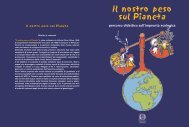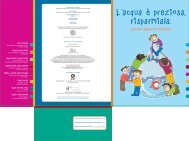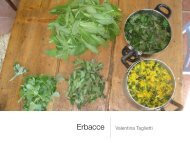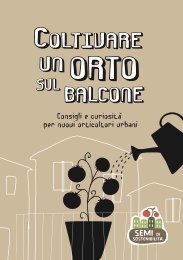Myanmar Protected Areas: Context, Current Status ... - Istituto Oikos
Myanmar Protected Areas: Context, Current Status ... - Istituto Oikos
Myanmar Protected Areas: Context, Current Status ... - Istituto Oikos
Create successful ePaper yourself
Turn your PDF publications into a flip-book with our unique Google optimized e-Paper software.
MOYINGYI WETLAND<br />
Site ID 27<br />
Locality Bago Region, Bago and Waw Townships<br />
Coordinates N 17° 32’, E 96° 36’<br />
Size (km²) 104<br />
Altitude (m. asl) 0 – 30<br />
<strong>Myanmar</strong> category Bird Sanctuary<br />
IUCN category IV<br />
Site Governance Nature and Wildlife Conservation Division<br />
Boundaries Demarcated<br />
Year gazetted 1988<br />
Protection level Partial (fishing allowed)<br />
Main purposes Conservation<br />
Habitat Wetland<br />
Key resources Wetland Ecosystem, Water Birds<br />
Legend of topographic maps<br />
Head Quarters<br />
Ranger Post<br />
Towns<br />
<strong>Protected</strong> <strong>Areas</strong><br />
State/Region Boundaries<br />
Roads<br />
Water areas<br />
Rivers<br />
Elevation<br />
5.800 m. asl<br />
0 m. asl<br />
Legend of satellite maps<br />
Water Depth Vegetation Density<br />
Deep<br />
Shallow<br />
High<br />
Low<br />
SITE DESCRIPTION<br />
The site is located around an artificial lake constructed in<br />
1904 in the Bago Region, 113 km far from Yangon City. The<br />
area is mostly flat. Therefore, it becomes flooded during<br />
the rainy season and dry during summer, although some<br />
permanent water bodies exist. It aims to conserve resident<br />
and migratory birds and their habitats, which also constitute<br />
the main attraction for tourists.<br />
NATURAL RESOURCES<br />
The site supports several wetland habitats with high<br />
ecological value for resident and migratory waterbirds. More<br />
than 20 aquatic plants are present, including Kaing grass and<br />
Nwaysaba (Oxyza officinalis), growing especially in the shallow<br />
areas of the site, which are a breeding ground for water birds.<br />
Checklists of 130 bird species, 20 reptiles, 9 amphibians, 45<br />
fish and 30 insects are compiled at the sanctuary office.<br />
MANAGEMENT<br />
The site is managed according to an annual management plan<br />
that includes patrolling activities, maintenance of roads and<br />
building and zoning programme. No human access is allowed<br />
in the core zone which is delimited by nets. In addition, a<br />
no-fishing zone is marked by poles. Nevertheless increasing<br />
conflicts with the poor local communities are reported. More<br />
patrolling against illegal fishing, environmental education<br />
campaigns and the involvement of local authorities are<br />
necessary actions for the conservation of site.<br />
<strong>Myanmar</strong> <strong>Protected</strong> <strong>Areas</strong><br />
68 69<br />
THREATS<br />
Overfishing, including illegal fishing techniques such as<br />
electric fishing, is the main threat for the site. Of moderate<br />
concern is the large number of water buffalos and other<br />
livestock grazing in the marshy areas of the sanctuary<br />
during the dry season. In addition, rice cultivation and<br />
human settlements are encroaching as the water level<br />
recedes within the basin.<br />
STAFF / RESOURCES<br />
The sanctuary has eight staff. The staff training level is<br />
satisfactory. Park warden, rangers and clerks have universitylevel<br />
education in environmental subjects. In addition,<br />
warden and rangers have received further training from<br />
Forest Department and NGOs. Nevertheless the level of IT<br />
skills is very low.<br />
In terms of infrastructure, the park warden office, where five<br />
staff are based, is located in the Pyin Bon Gyi village. Three<br />
ranger posts (1 staff each) are located in the villages of Kapin,<br />
Pyun Chaung and Pauk Taw. The information centre, nine<br />
boat houses and two rest houses are located close to the<br />
reservoir and are accessible by motor road. Another road (32<br />
km) surrounds the reservoir but is accessible only during the<br />
dry season. Basic tools and equipment (binoculars, telescope,<br />
GPS, camera, etc.) are available in the site. The office doesn’t<br />
have electricity or phone line for budget limitations. The birdwatching<br />
towers were destroyed by the Nargis cyclone in<br />
2007 and need to be rebuilt.<br />
TOURISM<br />
The site was visited by over 2,000 tourists in 2009. The<br />
potential is high for bird-watchers and nature lovers<br />
LAND USE AND HUMAN ACTIVITIES<br />
Fishing is tolerated in the basin for daily subsistence of local<br />
communities. 17 villages surround the site and mainly rely on<br />
rice cultivation. Rice fields are expanding inside because they<br />
are allowed by local authorities against the recommendations<br />
of Forest Department.<br />
RESEARCH<br />
Wetland biodiversity of the site has been studied by the<br />
Zoology Department of Yangon University, California<br />
Academy of Science, Wild Bird Society of <strong>Myanmar</strong> and the<br />
Forest Department.






